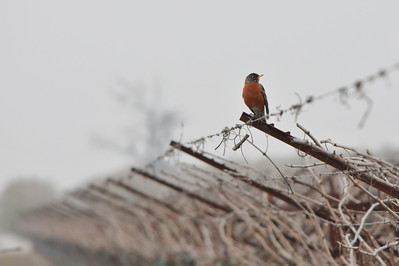
It is me again, trying to learn more about birds. I am trying with my shore birds, I am trying with my old field guides and my new Merlin ID app. And so, when I heard about a class to better identify bird song, I thought I should add one more tool to my feathery toolbox.
The instructor is so enthusiastic, so positive, so sure that anyone can learn bird calls. In many of the lectures, she talks about the birding mistakes and mishaps that she or others have made. I feel related to, I feel welcome. Still, I’m not much further than when I started.
I think my problem began with the robin. The American robin was given as an example of an ambassador bird, a bird that would help you pick out other birds in the thrush family. You could pick any bird you wanted, of course, but since I do know what robins look like, I figured I’d start there.
Call it the red breast phenomenon (or be more accurate and call it the Baader-Meinhof phenomenon)—now I see robins everywhere. They are picking through leaves under the elm tree, tucking themselves into berry bushes, landing on the grass at the park. But they are silent, these robins. I think they’re being quiet just to taunt me.
The only calls that I can recognize are the screechy ones. The ones I already know. The seagull. The crow. The scrub jay. The squeaky wheels of the bird world. OK, maybe I know two more: the morning dove’s coo, and the catch-all call of the mockingbird, which is a recent, pandemic addition to the repertoire. None of these are the charming ambassador birds that I’m supposed to be learning, the ones that will let you into the secrets of the wren family, the sweet, sunny call of the warbler.
I am listening more. The mix of calls I hear sounds like chaos to me, making me think that all of the ambassadors have pulled out of their embassies and left behind a clamor of birds without a country. And then yesterday morning, my husband and I were standing outside when a great blue heron flew overhead. And then, a second one flew by. We whooped and waved at our neighbors down the street, who were pointing upward, too. We’ve never seen one wide-winged heron soar above our street, let alone two. One of them made a creaky call that sounded like a sore-throated dog’s bark. Maybe an ambassador doesn’t have to have a voice like honey. Maybe it just needs to remind you to return to the country of attention.
*
Image by Andy Blackledge via Flickr/Creative Commons license
Thanks for this reflection, Cameron, on paying attention to birds as well as the fumbling and fruitful efforts of self-education. The NY Times also ran something on bird sounds today–“A 150,00-Bird Orchestra in the Sky.” (https://www.nytimes.com/2020/09/07/opinion/a-150000-bird-orchestra-in-the-sky.html)
Thank you, Rachel–I loved reading that story!